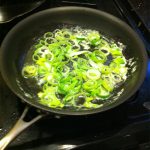 To fry lightly or brown in a little oil or fat.
To fry lightly or brown in a little oil or fat.
When you saute meat or vegetables, you shake the frying pan vigorously so the morsels of food jostle up and down and cook on all sides. This motion gives the saute its name, which derives from the French sauter, meaning to jump. Further back, the French sauter developed from the Latin saltare, meaning to jump repeatedly, which in turn derived from the Latin salire, meaning to jump. Many other words also developed from the Latin salire, including salient and salacious. Salient, which now means prominent, appeared in the sixteenth century to describe animals, on heraldic coats of arms, depicted as leaping upwards. By the eighteenth century, the word had shifted its application slightly as it came to describe points or ideas that seem to “leap” into prominence. Salacious, meaning lecherous, also derives from the Latin salire, which was sometimes used with the more specific meaning of to jump on a female in order to have sex. From this sense of the word arose the Latin adjective salax, meaning lustful, from which the English salacious was formed in the mid seventeenth century.
This passage refers to a cooking process that involves partially or completely cooking food in a shallow layer of fat that measures between one-eighth to one-quarter of an inch in depth. This technique is carried out on an open pan over a burner and is sometimes referred to as pan-frying.
Discover the art of quick cooking with a technique known as sautéing. In this culinary method, food is swiftly cooked in a small quantity of fat within an open pan. The term “sauté” originates from the French word “sauter,” meaning “to jump,” evoking the image of gracefully tossing the food in the hot fat. Embrace the dynamic nature of sautéing as it imparts a delightful sear and enhances the flavors of your culinary creations, all achieved through the swift and skillful dance of ingredients in the pan.
